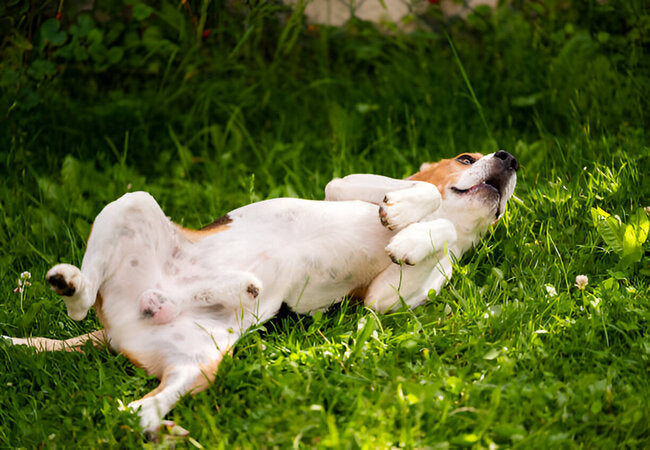Why Do Dogs Roll in Poop? Vet Explanations 2025 ✅🐶💩

In this article
Why Do Dogs Roll in Poop? Vet Explanations 2025 🐶💩
By Dr. Duncan Houston BVSc
If you've ever come home to your dog happily rolling in poo and wondered "Why on earth?"—you're not alone! In 2025, veterinarians view this behavior as rooted in instinct, communication, and sensory exploration. Let’s dive deep into the why, what it means, and how you can manage it effectively with empathy and guidance.
1. Instinctual Scent Camouflage 🦊
Wild canines often roll in strong smells to mask their own odor, helping when hunting prey. That natural drive still lives in domestic dogs today, making poop a prime target.
2. A Form of Communication 💬
By rolling, dogs carry the smell back to share with their pack, whether human or canine. It's a way of saying “Look what I found!”. Your pup is quite literally bringing the news.
3. Sensory Pleasure & Novelty 🎉
Dogs explore the world with their noses. Poop offers intense olfactory stimulation, creating a rich sensory reward for your pet.
4. Possible Anxiety or Excitement Release 😬
Some dogs roll in poop when they're stressed, bored, or overly excited—it can feel calming, triggering an “odor release” effect or grounded diversion during overwhelm.
5. Not About Dominance 🚫
Despite myths suggesting dogs do this to show dominance, experts confirm it's a primal or sensory behavior—not a power play.
When Poop-Rolling Becomes Problematic
- Health risks: Parasites, bacteria, and toxins linger in feces.
- Skin irritation: Residue may cause itching or rashes.
- Hygiene challenges: Grooming time increases dramatically!
Vet‑Approved Strategies to Manage Behavior
- Supervise outdoor time: Keep your dog within eyesight, especially during walk sniff sessions.
- Apply a cue like “leave it”: Reward your dog for moving away when you spot the temptation.
- Use long line training: Maintain control while giving freedom to explore.
- Distract and redirect: Throw a toy, praise engaging behaviors, or practice training cues before they roll.
- Clean up area promptly: Removing waste reduces opportunity and interest.
- Shower or wipe down after encounters: Use unscented, dog-safe options to remove odor from one roll before it becomes two.
- Reward non-rolling sniffing: Reinforce when they explore but don’t roll—build that good habit!
- Consult a behaviorist if needed: For anxious dogs, root causes may require a deeper plan.
Additional Preventive Measures
- Keep your lawn clean and waste-free.
- Enroll in beginner group obedience classes to reinforce cue response in distracting environments.
- Offer enrichment alternatives post-walk—like sniff mats or puzzle toys—to satisfy their sensory needs.
How You Can Respond in the Moment
- Say “leave it” calmly and walk them away—don’t chase or shout.
- Immediately reward when they disengage.
- Redirect them with an acceptable sniff or play option.
- Stay calm—if rolling happens despite your efforts, clean them without scolding and revisit the plan next time.
Understanding Motivations: A Quick Reference
| Motivation | What It Means | What To Do |
|---|---|---|
| Sensory Stress | Calming distraction | Use enrichment & soothing routines |
| Instinct | Camouflage habit | Redirect & reward non-rolling behaviors |
| Communication | Sharing scent info | Foster sniff enrichment elsewhere |
2025 Action Plan 📋
- 👀 Supervise walks and waste cleanup
- 🎯 Teach and reinforce “leave it”
- 🛁 Add post-walk clean-down routines
- 🐾 Offer sensory enrichment beyond poop
- 📱 Log incidents with Ask A Vet to identify patterns
FAQs 💬
• Is poop rolling harmful if vaccinated?
Yes—because of exposure to parasites and bacteria. Even protected dogs can have skin irritation or upset stomachs.
• Should I punish for rolling?
No—scolding won’t help and might reinforce the behavior. Redirect, reward, and stay proactive instead.
• Can I stop it forever?
Probably not entirely—it’s an instinct. But you can significantly reduce it with consistent training and cleanup strategies.
Conclusion ❤️
Rolling in poop may seem gross—but it’s rooted in natural dog instincts: camouflage, communication, and sensory exploration. With empathy, proven strategies, and consistent redirection, you can manage it while respecting your dog’s nature. In 2025, use cues, training, environmental control, hygiene plans, and enrichment tools from Ask A Vet, Woopf, and Purrz to tackle it effectively—without guilt or stress. 🐶✨
Need personalized support? Visit AskAVet.com or download the Ask A Vet app to connect with experts, log behavior, and get help anytime.






